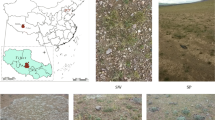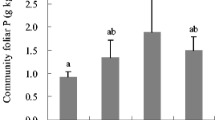Abstract
The micro-scale spatial distribution and loss of carbon, nitrogen and phosphorus were examined in degraded grassland near Ordos, in the Mu Us Sand-land, northwestern China. Five communities that represented a series of successionally degraded stages in desertification were chosen for the work. The dominant plant of Community 1 was the steppe grass Stipa bungeana; Community 2 was dominated by a mix of S. bungeana and the shrub Artemisia ordosia; Community 3 was A. ordosia; Community 4 was a mix of A. ordosia and the desert grass Cynanchum komorovii; and Community 5 was C. komorovii. The soils in root-spheres and in the bare openings between plants in five successionally degraded plant communities were analyzed for total organic carbon (TOC), total nitrogen (TN), inorganic nitrogen (IN), total phosphorus (TP), and available phosphorus (AP). The results showed that the heterogeneity process of the soil chemistry was characterized first by TOC heterogeneity and later by TN heterogeneity. The heterogeneity process of TP was only characterized in the community 3. No significant heterogeneity was present for AP in the five community stages. At the beginning of degradation, invasion by the shrub A. ordosia of S. bungeana grassland was found to lead to competition for soil elements between S. bungeana and A. ordosia and made the Community 2 soil environment temporarily homogeneous. In Community 3, however, the soil elements became spatially heterogeneous, and this led to the development of `islands of fertility'. The concentrations of soil elements (TOC, TN and IN) were greatest in the shrub root-spheres. With further desertification (from Community 4 to Community 5), the islands of fertility began to collapse, and the concentrations of the main soil elements declined rapidly. The dynamics of soil phosphorus under progressive desertification were different from those of the other soil elements. TP decreased from form Community 1 to Community 5, while the AP concentration did not change in mid-level desertification (Community 3), but increased with serious desertification (Community 5).
Similar content being viewed by others
References
Breshears D D and Barnes F J 1999 Interrelationships between plant functional types and soil moisture heterogeneity for semiarid Landscapes within grassland/forest continuum: A unified conceptual model. Landsc. Ecol. 14, 465–478.
Burke I C 1989 Control of nitrogen mineralization in a sagebrush steppe landscape. Ecology 70, 1115–1126.
Burke I C, Reiners W A and Schimel D S 1989 Organic matter turnover in a sagebrush steppe landscape. Biogeochemistry 7, 11–31.
Burke I C, Lauenroth W H, Vinton M A, Hook P B, Kelly R H, Epstein H E, Aguiar M R, Robles M D, Aguilera M O, Murphy K L and Gill R A 1998 Plant-soil interactions in temperate grasslands. Biogeochemistry 42, 121–143.
Charley J L and West N E 1975 Plant-induced soil chemical patterns in some shrub-dominated semi-desert ecosystems of Utah. J. Ecol. 63, 945–963.
Charley J L and West N E 1977. Micro-patterns of nitrogen mineralization activity in soils of some shrub-dominated semi-desert ecosystems of Utah. Soil Biol. Biochem. 9, 357–365.
Cheng X L, An S Q, Li G Q, Cheng X L, Wang Y J and Li J. 2001a The correlation between the desertification of grassland and the change of vegetation characteristics in Ordos. J. Nanjing Univ. 37, 230–239 (in Chinese with English abstract).
Cheng X L, An S Q, Cheng X L, Li G Q and Liu S R 2001b The correlation between the desertification of grassland and the change of vegetation biomass in Ordos. Sci. Sil. Sini. 37, 13–20 (in Chinese with English abstract).
Cross A F, Schlesinger W H 1999 Plant regulation of soil nutrient distribution in the northern Chihuahuan Desert. Plant Ecol. 145(1): 11–25.
Fisher F M, Zak J C, Cunningham, G L and Whitford W G 1987 Water and nitrogen effects on growth and allocation patterns of creosotebush in the northern Chihuahua Desert. J. Range Manag. 47, 387–391.
Garner W and Steinberger Y 1989 A proposed mechanism for the formation of ‘Fertile Island’ in the desert ecosystem. J. Arid Environ. 16, 257–262.
Greig-Smith P 1983 Quantitative Plant Ecology. 3rd ed. Blackwell Scientific Publications, London.
Hook P B, Burke I C and Lauenroth W K 1991 Heterogeneity of soil and plant N and C associated with individual plants and opening in North American shortgrass steppe. Plant Soil 138, 247–256.
Huenneke L F, Anderson J P, Remmenga M and Schlesinger W H 2002 Desertification alters patterns of aboveground net primary production in Chihuanhuan ecosystems. Global Change Biol. 8(3): 247–264.
Jackson R B, Manwaring J H and Caldwell M M 1990 Rapid physiological adjustment of roots to localized soil enrichment. Nature 344, 58–60.
Jackson R B and Caldwell M M 1993a The scale of nutrient heterogeneity around individual plants and the quantification with geostatistics. Ecology 74, 612–614.
Jackson R B and Caldwell M M 1993b The geosatistical patterns of soil heterogeneity around individual perennial plants. J Ecol. 81, 683–692.
Katherinel G, Kurts P and Andrew J B 1995 Spatial variation in nitrogen availability in three successional plant communities. J. Ecol. 83, 357–367.
Kieft K L, White C S, Loftin S R, Aguilar R, Craig J A and Skaar D A 1998 Temporal dynamics in soil carbon and nitrogen resources at a grassland-shrubland ecotone. Ecology 79, 671–683.
Li X R 1997 The characteristics of the flora of the shrub resource in Maomusu sandland and the countermeasures for the protection. J. Nat. Res. 12, 146–152 (in Chinese with English abstract).
Li X R 2001 Study on shrub community diversity of Ordos Plateau, Inner Mongolia, Northern China. J. Arid Environ. 47, 271–279.
Lin N F and Tang J. 2002. Geological environment and causes for desertification in arid-semiarid regions in China. Environmental Geology. 41(7), 806–815.
Mouat D, Lancaster J, Wade T, Wickham J, Fox C, Kepner W and Ball T 1997 Desertification evaluated using integrated environmental assessment model. Environ. Monit. Ass. 48, 139–156.
Nelson D W and Sommers L E 1980 Total nitrogen analysis for soil and plant tissues. J. Assoc. Anal. Chem. 63, 770–778.
Robertson G P, Huston M A, Evans F C and Tiedje J M 1988 Spatial variability in a successional plant community: patterns of nitrogen availability. Ecology 69, 1517–1524.
Robertson G P, Crum J R and Ellis B G 1993 The spatial variability of soil resources following long-term disturbance. Oecologia 96, 451–456.
Robertson G P and Gross K L 1994 Assessing the heterogeneity of belowground resources: quantifying scale. In Exploitation of Environmental Heterogeneity by Plants. Eds. Caldwell MM Pearcy RW, pp. 237–253. Academic Press, New York, USA.
Schlesinger W H, Reynolds J F, Cunningham G L, Huenneke L F, Jarrell W M, Virginia R A and Whitford W G 1990 Biological feedbacks in global desertification. Science 47, 1043–1048.
Schlesinger W H, Raikes J A, Hartley A E and Cross A F 1996 On the spatial pattern of soil nutrients in desert ecosystem. Ecology 77, 364–374.
Schlesinger W H, Aberhams A D, Parsons A J and Wainwright J 1999 Nutrient losses in runoff from grassland and shrubland habitats in Southern New Mexico: I. Rainfall simulation experiments. Biogeochemistry 45, 21–34.
Schlesinger W H, Ward T J and Anderson J 2000 Nutrient losses in runoff from grassland and shrubland habitats in southern New Mexico: II Field plots. Biogeochemistry 49, 69–86.
Seixas J 2000. Assessing heterogeneity from remote sensing images: the case of desertification in southern Portugal. Int. J. Rem. Sens. 21, 2645–2663.
Shachak M, Sachs M and Moshe I 1998 Ecosystem management of desertified shrublands in Israel. Ecosystem 1, 475–483.
Snyder J D and Trofymow J A 1984 A rapid accurate wet oxidation diffusion procedure for determining organic and inorganic carbon in plant and soil samples. Commun. Soil Sci. Plant Anal. 15, 587–597.
Sun S C and Liu G Z 1997 Study on the patterns of Convolvulus Tragacuthoiedes population in the upper reaches of the Minjiang River. Chin. J. App. Environ. Biol. 3, 193–198 (in Chinese with English abstract).
Tongway D J and Ludwig J A 1994 Small-scale resources heterogeneity in semi-arid landscapes. Pacific Conserv. Biol. 1, 201–208.
Zhang X S 1994 The optimization pattern and principle of grassland construction and ecological background of Maomusu sandland. Acta Phytoecol. Sini. 18, 1–16 (in Chinese with English abstract).
Zheng H L and Z C Huang 1992 Physiological ecology study on Artemisia Ordosica and Cynanchum Komarovii in the maowusu sandland. Acta Phytoecol. et Geobo. Sini. 16: 197–207 (in Chinese with English abstract).
Yang B Z, Dong X J, Gong Q, Liu Z M and Al D B 1994 A study on the transpiration and water-defict regime of the Artemisia Ordosica community. Acta Phytoecol. Sini. 18, 161–170 (in Chinese with English abstract).
Author information
Authors and Affiliations
Rights and permissions
About this article
Cite this article
Cheng, X., An, S., Liu, S. et al. Micro-scale spatial heterogeneity and the loss of carbon, nitrogen and phosphorus in degraded grassland in Ordos Plateau, northwestern China. Plant and Soil 259, 29–37 (2004). https://doi.org/10.1023/B:PLSO.0000020948.66471.2b
Issue Date:
DOI: https://doi.org/10.1023/B:PLSO.0000020948.66471.2b




